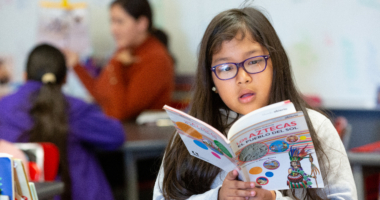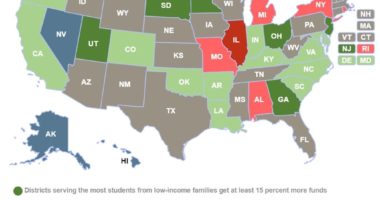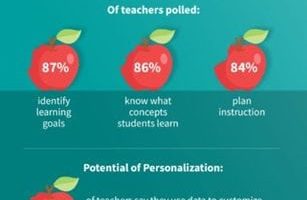Community Organizing for Teacher Compensation
By: kyle lim – Urban Core Collective
The Urban Core Collective exists to support the self-determination and agency of historically marginalized communities by engaging in advocacy, community organizing, and leadership cultivation. We do this to transform living conditions and the distribution of power in the greater Grand Rapids area. Our Education Justice team supports students, parents, and building-level staff in organizing to bring about a vision of Healthy and Healing schools in Grand Rapids, MI.
Like all good things should, we begin by listening. The questions are always open-ended: “What are the issues going on at your school?” “If you could do something differently, what would it be?” And perhaps most importantly, “How do you want to get involved?” It’s amazing how much people open up when they’re offered a warm meal and an opportunity to be heard.
As we listened, we worked with students, parents, and caregivers to analyze and research the dynamics being raised. There are many issues that need solving in our schools – food quality, reliable transportation, aging infrastructure, school safety – all critical components to a healthy and healing educational experience. However, one issue in particular seemed completely at odds with the very notion of school: many of our buildings lack access to certified teachers.
According to data we received from the Grand Rapids Education Association (GREA), there were more than 230 vacant classroom positions last year, and unqualified substitutes were used to cover roughly twelve thousand days of vacancies. These shortages disproportionately affect school communities suffering from a legacy of neglect and social inequity. Like many school districts, Grand Rapids Public Schools (GRPS) is caught in a social landscape rife with racial and economic segregation. In 2023, one quarter of GRPS’ Black students were concentrated in a specific neighborhood-school feeder pattern (elementary → middle → high). Not only were the schools in this feeder pattern chronically understaffed, they were also staffed by mostly new and inexperienced teachers. This means that a student within this predominantly Black school feeder pattern could spend the entirety of their K-12 experience with brand new teachers or without a qualified teacher at all, according to data as of June 2023.
GRPS Director of Communications and Community Liaison Luke Stier shared that the district is “proud of the progress they are making to have qualified teachers in every classroom.” As of December 2, 2024, they were down to 95 teaching position openings districtwide, Stier said. In the specific neighborhood school feeder pattern of Campus > Alger > Ottawa Hills, there is a combined total of 6.5 teaching position openings in those three schools, Stier added.
The issue of staffing is complex. Nationally, teachers continue to be among the lowest-paid professionals requiring advanced education. A teacher with a bachelors degree in Grand Rapids Public Schools must work approximately sixteen years within the district to earn a wage that would support a family of four in Kent County. (2) Local districts like GRPS, however, are being asked to do more than ever while school funding remains largely insufficient. Most urban public schools do not have the funds to increase pay immediately. As a state, we need to pressure our legislators to increase education revenue for schools. We cannot simply ask schools to provide the level of service our students deserve if they do not get more money. Advocacy groups like the Michigan Education Justice Coalition, Michigan Partnership for Equity and Opportunity, EdTrust-Midwest, and labor groups like the Michigan Education Association are great examples of people coming together across the state to advocate for increasing education funding. We invite you to join us in the near future as we find ways to come together to support our schools.
Lastly, it is essential you begin to get organized. Local districts need to be held accountable to ensure that additional funding is invested in their greatest resource: their building-level staff. In Grand Rapids, our communities WANT to be involved in decision-making that affects our schools. We continue to advocate for spaces where local stakeholders can be actively involved in district and building-level decision-making, including critical decisions like how money is spent.
Remember that your community needs you. They need you to push for equitable funding for your schools. They need you to make sure that money is spent wisely. They need you to make space to listen, to build power, and to enact change. Here are a few ways you can get involved:
- Connect: Reach out to your local teacher union to find out what staffing looks like in your district’s schools. Pay attention to the schools with the lowest (or least experienced) staffing rates. Talk to other parents, students or staff to begin to identify what your local issues might be.
- Research: Build your knowledge around the revenue gap that exists for schools. If you’re in Michigan, here are some great resources:
- SFRC
- EdTrust-Midwest Research
- Organize: Begin building power to address your school issues. This could be to advocate for more school funding, or it could be for local accountability. If you need help, see if any local organizations might be willing to support you! (Michigan folks see here)
(1) This data comes from a UCC analysis of public information from MISchool Data and nonpublic Grand Rapids Public Schools staffing data.
(2) The Household Survival Budget (HSB) reflects the minimum cost to live and work in the current economy and includes housing, child care, food, transportation, health care, technology, and taxes. The 2022 HSB for a family of four in Kent County was $69,348 (2022). Estimates on the number of years it would take an educator with a bachelors degree to meet that threshold in GRPS were created by UCC using GRPS salary step information provided by GREA.
This blog was originally featured in EdTrust-Midwest’s report, Closing the Opportunity Divide: Addressing Michigan’s Teacher Shortage Problem for Students Most in Need.






